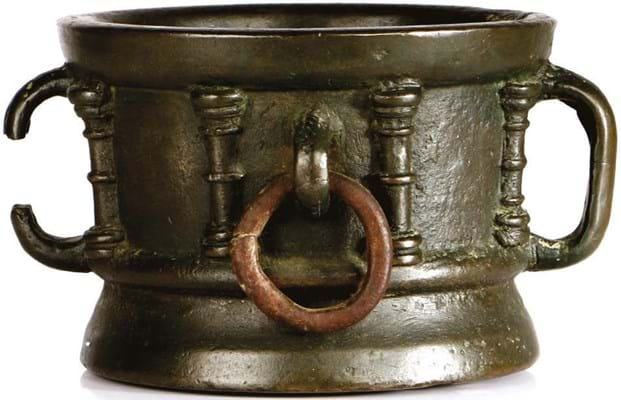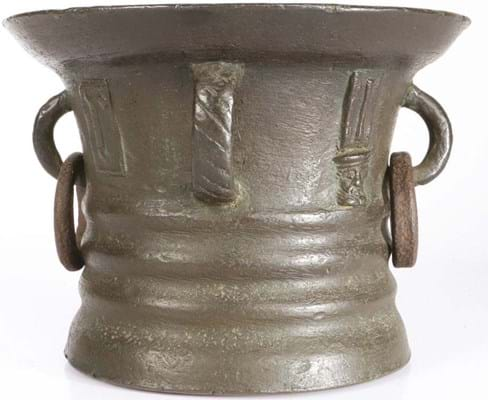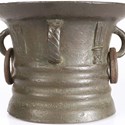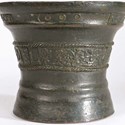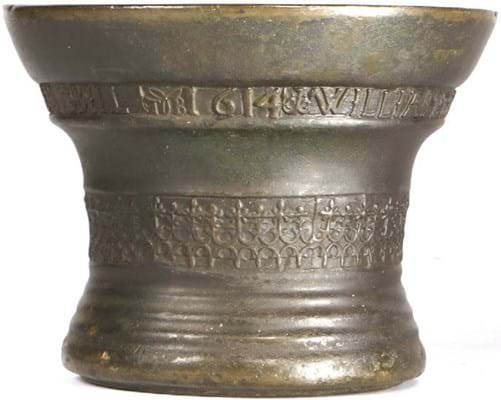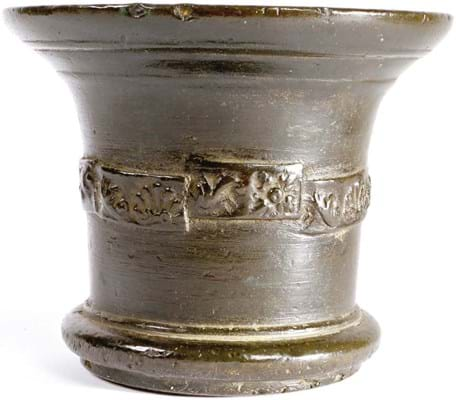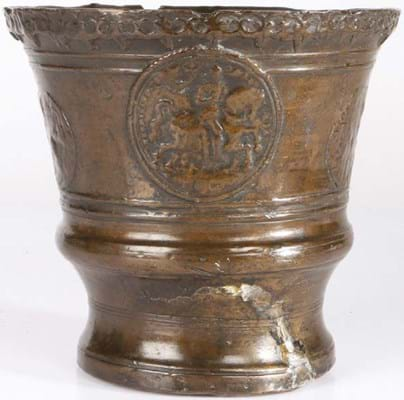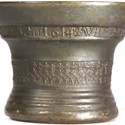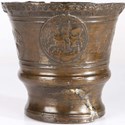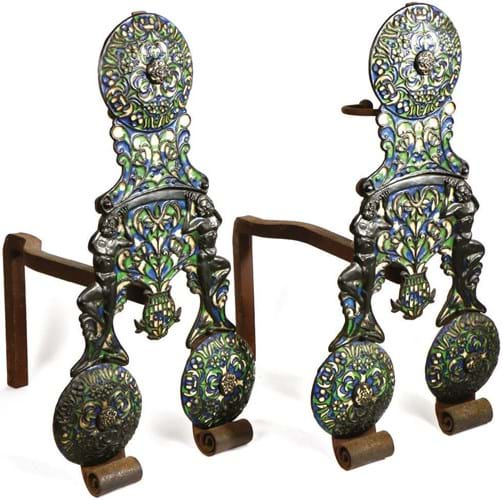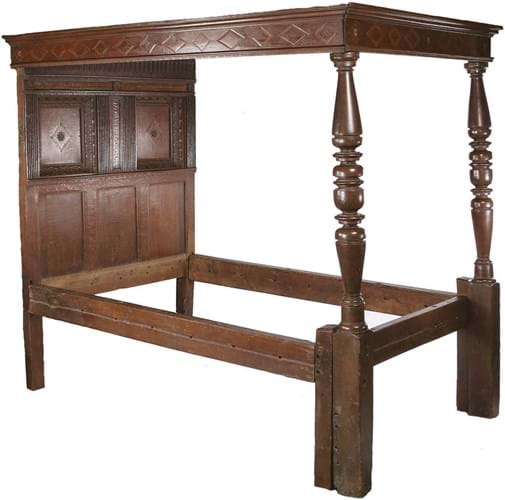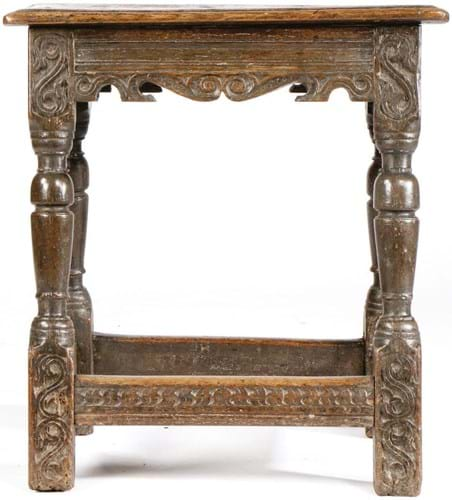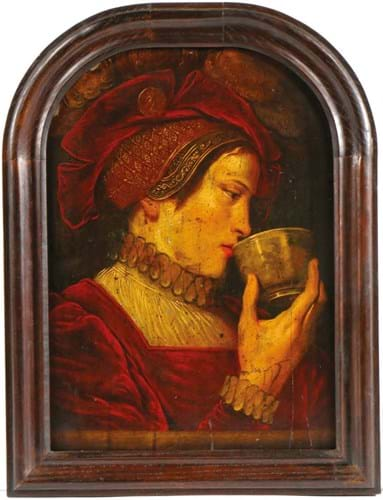Led by a £27,000 Elizabethan bed and including desirable early bronze mortars, a rare pewter spoon and a portrait oil on panel by Van Dyck’s artisan associate, the specialist Oak Interior sale at Bishop & Miller (22% buyer’s premium) revealed collectors willing to shell out for the right material across the board.
That some 38% of the 695 lots failed to get away in the rooms was evidence of a selective market but a total of just under £400,000 told its own story.
With a few exceptions, UK collectors were the dominant bidders.
Probably the main attention grabbers at the September 28-29 Stowmarket sale were the early bronze and bell metal mortars, in particular the 10 entered from the estate of metalware dealer Christopher Bangs (1951-2022) who died of Chronic Obstructive Pulmonary Disease in May (Obituary, ATG No 2558).
A colourful character, Bangs had been an academic, author, V&A librarian, Grosvenor House Fair vetter and, since 1996, owner of the smart private gallery Triangle in Fulham.
Of the mortars mentioned here, the first four were consigned from his estate and sold to private UK buyers.
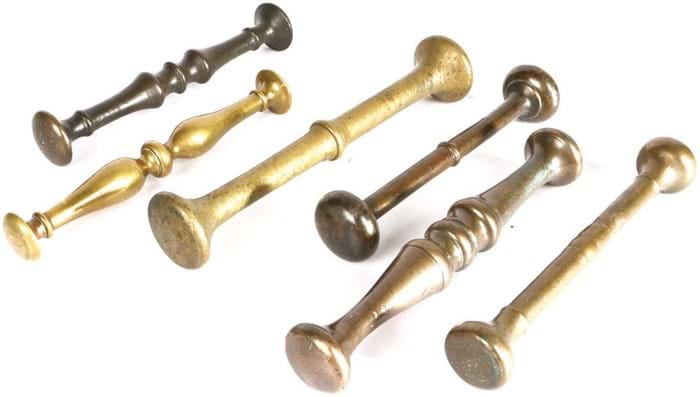
Complementing the mortars at Bishop & Miller were a few multi-lots of bronze pestles. This group of six 17th-18th century pestles, the largest 8½in (22cm) long, comprised three of endorsed baluster form, and three with central fillets. Estimated at £30-40, they sold to a UK dealer at £180.
Domestic metalware
Other domestic metalware from the Bangs estate and other sources was in demand.
A small 15th or early 16th century bronze cauldron on splayed legs featured mask retainers for the articulated handle. Just 4¾in (12cm) diameter and 7½in (19.5cm) high to the handle, it was pitched at £2000-3000 and sold online at £4400 to a collector who secured two of the top-selling mortars.
Bangs will be remembered for his writing on early European bronze and brass candlesticks: The Lear Collection – A Study of Copper-Alloy Socket Candlesticks AD200-1700 is an excellent reference work on the subject.
Leading light among the 27 candlesticks offered here, mostly 16th and 17th century examples, was an 8in (20cm) tall, c.1680, brass clusterstem socket example. Featuring eight conjoined columns bound by three ridged bands, rising from a square base and topped with a scalloped rim, it sold to a collector on the lower £4000 estimate.
A c.1680 pair of andirons were exceptional for their blue, green and white Surrey enamel decoration – so called because in 1931 the authoritative CR Beard identified the form as originating in Esher.
However, it may be a misnomer: in his 2005 work, Claude Blair attributes the style to the London workshops of Anthony Hatch and Stephen Pilcherd. There was no disputing their popularity either way – the pair sold above estimate online at £3900.
An English meat fork, c.1680-1700, doubled mid-expectations in selling to a US collector in the room at £2000. Decorated to the stem with ornate heart terminals and tight scrolls to the centre, it measured 17½in (44cm) long.
Anything that could reasonably be made of pewter was among the 70 lots in the Suffolk rooms but the current toughness of the market resulted in just over half getting away.
Rarity and real quality, however, still make an impact, conditions met by a c.1560-80 figural spoon.
The 4¾in (12cm) long spoon with wrigglework scroll decoration to the fig-shaped spoon had a rare terminal shaped as a standing robed woman with facial features and hands on hips. It doubled the high estimate to take £4000.
Try a tester
Topping the sale was a c.1570-90 oak and inlaid tester bed.
Measuring 6ft 2in long x 5ft 2in wide (2.17 x 1.59m), it was in good condition and provenanced to Lord Ivar Mountbatten’s Elizabethan manor Moyns Park in Essex, home of Sir Thomas Gent, Baron of Exchequer to Elizabeth I and, until the 19th century, his descendants.
Each of the 12 panels to the tester was linear chequer inlaid with a large single lozenge and the whole bed featured parquetry, various ziz-zag carving, inlaid flowerheads and punch decoration.
Estimated at £15,000-20,000, it sold at £27,000.
Joint stools, ubiquitous as they are at early oak auctions, need to be in pleasing original condition to make good money.
Here a rare c.1600-20 West Country example was deemed the best offering of 40 wide-ranging lots in the sale provenanced to Doughton Manor in Gloucestershire.
Standing 21½in (54cm) tall, it had a doubled-reeded top, moulded rails and scroll carved and punch decorated lower edge on inverted baluster turned legs. Pitched at £3000-4000, it made £8800.
Also from Doughton was a pair of c.1630 stools with single-reeded long edges, lunette carved rails and rising baluster legs that – unusually for English stools of the period – were united by slightly inset stretchers. They sold at £10,500, more than twice the mid-estimate.
From the same source was a c.1560 decorative carved and polychrome painted oak panel of a coat of arms against a strapwork ground with a Latin inscription identifying the Armiger family. Measuring 6½ x 9in (42 x 23cm) and pitched at £800-1200, it took £3300.
Another eyecatcher for the wall of an oak-filled room was a 17th century oil on board portrait within an arched frame of a lady holding a cup of oil. The reverse of the 21 x 28in (53 x 70.5cm) panel bore the stamp marks for the City of Amsterdam and GH, attributed to Guilliam Gabron who was Van Dyck’s favourite panel maker.
It sold on the lower £3000 estimate.
Staffordshire dishes
Leading the ceramics were three c.1780 Staffordshire dishes from Doughton, with creamy calligraphic or ribbon slip on dark brown backgrounds.
Collectively estimated at £2200-3300, they sold to a UK dealer and a private rival for a hammer total of £9000. The best, measuring 13in (34cm) across, was estimated at £1000-1500 but sold at £4400.
A series of stone carvings met some resistance, although a possibly 12th century 9in (23cm) high carved gritstone head of a bearded man at £600 and a similarly dated and sized limestone grotesque at £900 were decent results.
Earliest and best by a distance was a 17in (44cm) tall Celtic stone boundary or grave marker with a carved figure to each side and a cross front and rear. Dated c.400BC and estimated at £2000-4000, it went to the trade at £6800.


